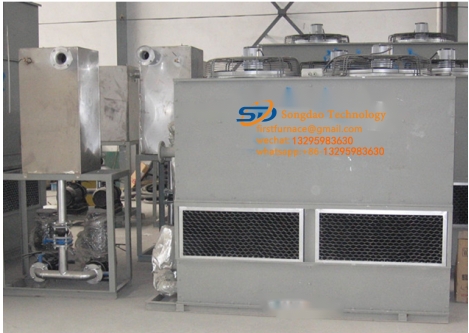- 26
- Apr
Principle of water cooling system for induction melting furnace
Principle of water cooling system for induction melting furnace:
1. Principle of water cooling system for induction fusion fio:
The working fluid circulates in the coil of the closed cooling tower, the heat of the fluid is transferred through the tube wall, and forms saturated hot and humid steam with water and air. During the circulation process, the spray water reduces the water temperature through the PVC heat sink, and forms wind and water flowing in the same direction as the fresh incoming air. The coil mainly relies on the sensible heat conduction.
2. The air inlet form of the water cooling system of the induction melting furnace: the form of composite flow from the same direction of wind and water.
3. Advantages of water cooling system for induction melting furnace:
a. The water cooling system of the induction melting furnace is easy to maintain:
① The huge space in the tower provides revolutionary convenience for the routine maintenance of the equipment, and the coils, water retaining plates, PVC heat sinks, etc. can be maintained in the tower.
② Key parts – the maintenance of the coil is much easier due to the reasonable structure of the equipment, and a single group of coils can be pulled out of the tower body for maintenance.
③ The spray nozzles, spray pipes and water tanks of the spray system have the most maintenance times, while the spray system is completely exposed, and there are special guardrails and ladders to provide convenience, which is very convenient.
b. Induction melting furnace water cooling system to prevent scaling:
Counter-flow closed-circuit cooling towers have never had a good way to prevent scaling of the cooling coils. This product is the biggest feature of the product itself in solving the scaling of the cooling coil. The factors are as follows:
① The spray water flows in the same direction as the inhaled new air, so that the spray water can wrap the outer wall of the pipe and completely wet it, avoiding the formation of dry spots at the lower part of the pipe like similar products in the counterflow method, and avoiding the dry spot. Scale is formed.
② The lower water temperature makes it difficult for calcium and magnesium crystalline substances that are easy to form scale to adhere to the steel pipe, avoiding the accumulation of scale. The PVC heat dissipation layer arranged in the equipment is used to reduce the water temperature.
③ The heat exchange method is to exchange heat through the sensible heat of the wet surface of the pipe and the latent heat of the heat-absorbing pipe wall, which is beneficial to prevent scaling.

